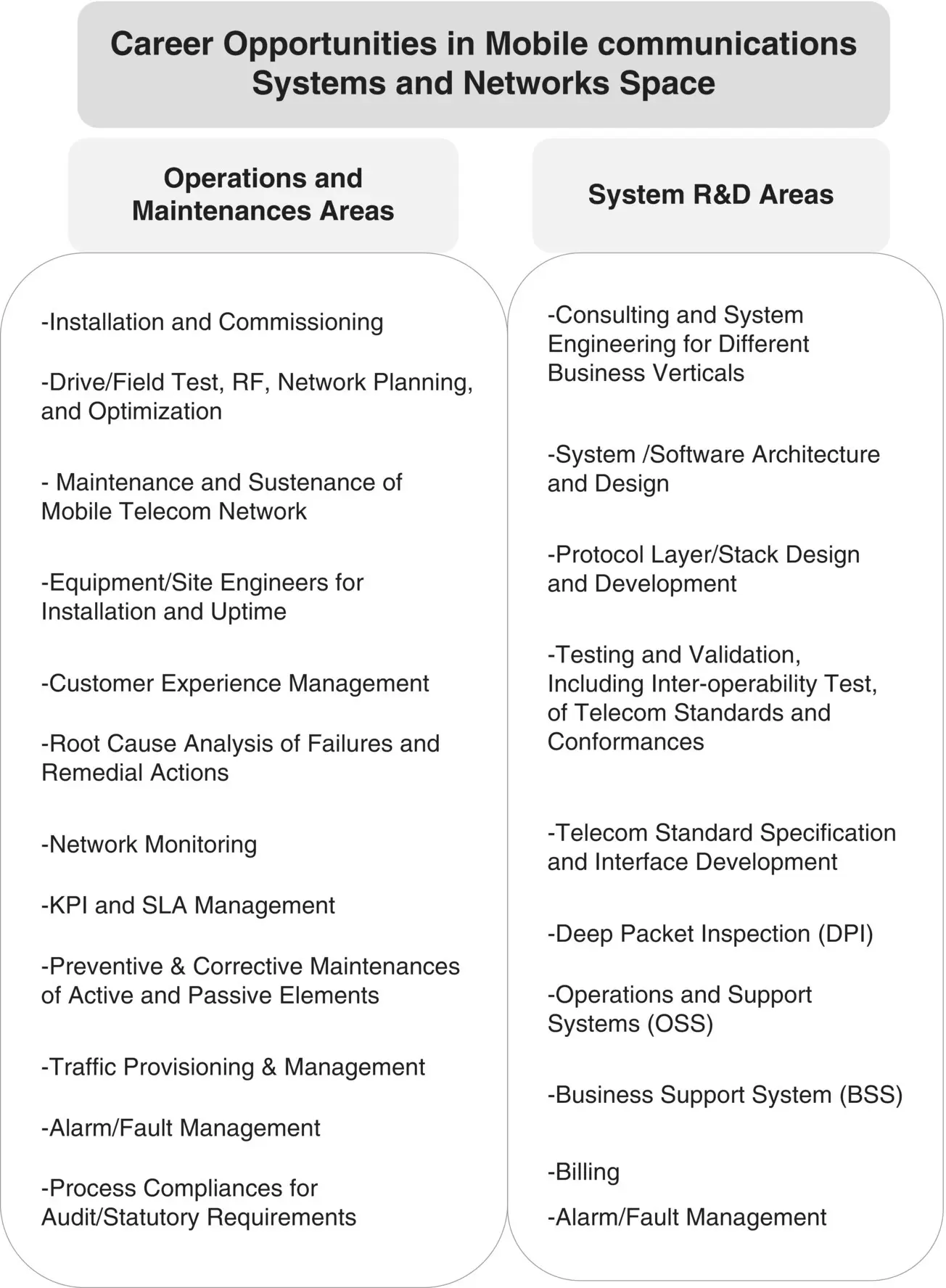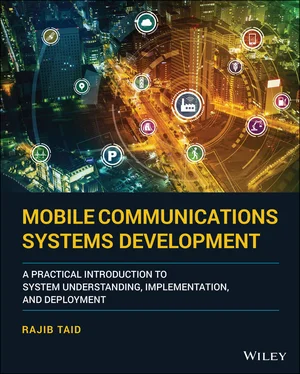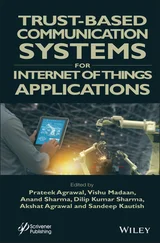1 Introduction : Career Opportunities in Mobile Communications Networks Space
You see, wire telegraph is a kind of a very, very long cat. You pull his tail in New York; and his head is meowing in Los Angeles. Do you understand this? And radio operates exactly the same way: you send signals here, they receive them there. The only difference is that there is no cat.
Source: Albert Einstein .
Gone are the days when mobile phones were considered a luxury; today, it is among our daily necessities. Mobile communications have evolved quickly and revolutionized the way we communicate and have brought people around the globe closer than ever before. At the same time, the mobile telecom industry has witnessed an explosive growth rate over the past many years, offering a wide range of services and products.
The latest trend is the availability of multitasking smartphones and various apps for different services and capabilities for our day‐to‐day needs. The combination of smartphones and Apps is enabling mobile broadband services to everyone, everywhere, and anytime on the go. This is leading to a growing demand for smartphones along with manifold increase in Internet traffic. The legacy mobile communications network standards such as Global System for Mobile Communication (GSM) (2G), General Packet Radio Service (GPRS) (2.5G), Universal Mobile Telecommunication System (UMTS) (3G), Long‐Term Evolution (LTE) (4G), and the emerging and latest buzzword 5G, along with the growth in the number of mobile subscribers, have created a gap between the demand and supply of skilled mobile communications professionals.
The mobile communications industry is a key driver and offers immense employment opportunities. The advent of the 5G system and network is expected to create and offer more opportunities for various professionals and business owners. Communications solution service providers, network installers, original equipment manufacturers (OEMs), and communications software solution services provider firms are demanding skilled and experienced professionals. In the mobile communications space alone, career opportunities exist across these different verticals and areas. Some of these career opportunities are shown in Figure 1.1.
The career opportunity areas shown in Figure 1.1are at a very high level only. Each of the areas shown spans across multiple systems and subsystems. Opportunities exist at an entry‐level or experienced professional level for various job roles such as software developer and maintenance, team leader, project manager, system architect and engineering, site engineer, network engineer, network operation and maintenance, and so on.
Mobile communications systems and networks are built based on open technical standards, covering a wide spectrum of knowledge areas as illustrated in Figure 1.1. The knowledge areas are spread across the different system engineering areas of mobile communications systems and networks. This book attempts to cover some of those knowledge areas from a practical point of view, so that one can be self‐equipped to start a career in the mobile communications domain.

Figure 1.1 Career opportunities in the mobile communications space.
Part I Network Architectures, Standardization, Protocols, and Functions
Mobile communications systems and networks based on the GSM/GPRS, UMTS, LTE, and 5G systems and technologies consist of telecommunications infrastructures to provide communications services to mobile users. In this first part of the book, several knowledge areas of legacy mobile communications systems and networks which are based on the GSM/GPRS, UMTS, and LTE technologies as well as 5G systems are covered. The 5G system shall be covered exclusively in Part IV of this book. Because even if a reader is starting a career in LTE, 5G, or the latest, system and network, and as a developer or O&M person, one must know the major key concepts from the legacy GSM/UMTS/LTE networks as well. The network architectures and their protocols; the 3GPP standardization processes; systems engineering; functions such as the network identities, packet encapsulations, and interworking of network aspects of the GSM/GPRS, UMTS, LTE, and 5G system are discussed. This part of the book contains eight chapters, and their purposes are as follows.
Chapter 2describes the architectures and their domains of the GSM, GPRS, UMTS, and LTE networks. The standardization processes used by the 3GPP and evolutions of mobile communications networks based on the GSM, GPRS, UMTS, LTE, and 5G systems are also described. The System Engineering aspects of mobile communications networks are described briefly.
Chapter 3describes the architecture and different types of protocols found within the mobile communications systems and networks, which are based on the legacy GSM, GPRS, UMTS, LTE system as well as the 5G system. Various interfaces for peer‐to‐peer protocol layers communications are also described.
Chapters 4to 9describes some of the essential functions that are performed by the mobile communications systems and networks, which are based on the legacy GSM, GPRS, UMTS, LTE, and the emerging 5G system to provide seamless communications services to mobile users within a particular network or across the networks.
2 Network Architectures, Standardizations Process
Introduction
This chapter provides the introductory and high‐level architectures of the legacy mobile communications systems which are based on the Global System for Mobile Communication (GSM), Universal Mobile Telecommunication System (UMTS), and Long‐Term Evolution (LTE) systems. However, being legacy and general, some of the contents of this chapter apply to the 5G system also. The architecture of the 5G system shall be covered in Part IV of this book. We begin with the basic network architecture of the legacy GSM system, followed by the architectures of UMTS and LTE systems as well. Following this, we present the different domains or areas of a mobile communications network along with their network elements that are interconnected together to provide communication services to users. The evolution of different mobile communications systems is presented. We also cover the system engineering aspects of a mobile communications network that span across its different domains or knowledge areas.
We then present the standardization processes used for mobile communications systems and networks that are available currently. Standardization is important for successful developments and integrations of multivendor network elements of a mobile communications system and network. Different features added, in terms of a release, during the evolution of a particular mobile communications system are also summarized.
2.1 Network Elements and Basic Networks Architectures
A mobile communications network based on the GSM (2G)/General Packet Radio Service (GPRS) (2.5G), UMTS (3G), and LTE (4G) technology comprises the interconnected network of different communicating entities/nodes, called as the network element . Based on a particular communications technology, a mobile communications network comprises several network elements. In the case of a GSM and GPRS network, the network elements are MS (Mobile Station), BSC (Base Station Controller), BTS (Base Transceiver Station), MSC (Mobile Switching Center), SGSN (Serving GPRS Support Node), and GGSN (Gateway GPRS Support Node). In the case of the LTE/Evolved Packet System (EPS) network, the network elements are User Equipment (UE) (mobile station), eNodeB, Mobility Management Entity (MME), Serving Gateway (S‐GW), and Packet Data Network (PDN). These interconnected network elements provide end‐to‐end communication services like voice (Circuit Switched – CS domain in case of GSM and UMTS) and data (Packet Switched – PS domain in case of GPRS and LTE), multimedia contents to subscribers.
Читать дальше













